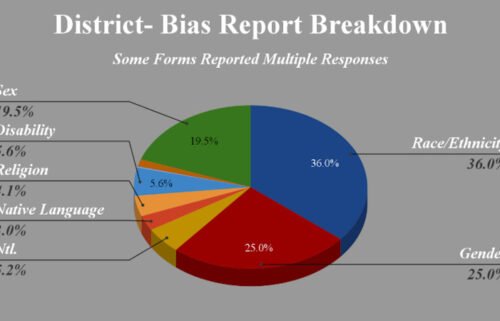What’s in the Democrats’ package on climate, health care and taxes
CNN, CNN BUSINESS
By Tami Luhby and Katie Lobosco, CNN
The Democrats’ budget reconciliation package, which contains several landmark climate and health care provisions, was signed into law by President Joe Biden Tuesday.
The House passed the legislation, titled the Inflation Reduction Act, Friday after being approved by the Senate on August 7 on a party-line vote.
Still, the effort remains a mere shadow of the sweeping $3.5 trillion reconciliation package that the majority party initially floated last year.
After torpedoing the inclusion of any climate or tax provisions in mid-July, West Virginia Sen. Joe Manchin, a moderate Democrat, reversed course. The measures join a handful of important but narrow provisions to lower prescription drug prices and to extend enhanced Affordable Care Act subsidies for three years.
Gone are the creation of a universal pre-K program, an extension of the enhanced child tax credit, an expansion of Medicare benefits, the establishment of a federally funded paid family and sick leave program and many other provisions aimed at broadening the nation’s social safety net.
The deal is far smaller than the slimmed-down $1.75 trillion version the House passed in October. But Manchin, whose vote is crucial to pushing any legislation through the Senate via the reconciliation process, shot down the House bill in December. Only a simple majority of senators was needed to pass the bill via reconciliation.
Since then, Democratic leaders had been negotiating with Manchin to see what he’d be willing to support. The senator had repeatedly voiced concerns about the legislation’s potential impact on inflation, which has skyrocketed over the past year. Economists, however, disagree about the actual extent of the legislation’s effect on inflation.
The latest version of the package, which Biden signed into law Tuesday, is projected to reduce the deficit by more than $300 billion over a decade, according to the Congressional Budget Office.
Here’s what’s in the legislation:
Medicare drug price negotiation: The legislation will empower Medicare to negotiate prices of certain costly medications administered in doctors’ offices or purchased at the pharmacy. The Health and Human Services secretary will negotiate the prices of 10 drugs in 2026, and another 15 drugs in 2027 and again in 2028. The number is set to rise to 20 drugs a year for 2029 and beyond.
This controversial provision is far more limited than the one House Democratic leaders have backed in the past. But it will open the door to fulfilling a longstanding party goal of allowing Medicare to use its heft to lower drug costs.
Inflation cap: The legislation will also impose penalties on drug companies if they increase their prices faster than inflation, starting in 2023. However, the Senate parliamentarian ruled that the provision could only apply to Medicare, not the private insurance market as well, as the Democrats had wanted.
Limit on Medicare out-of-pocket drug costs: The law will redesign Medicare’s Part D drug plans so that seniors and people with disabilities won’t pay more than $2,000 a year for medications bought at the pharmacy, starting in 2025. Insurers and drugmakers will have to pick up more of the tab.
Free vaccines for seniors: Medicare enrollees will be able to get all vaccines at no cost. Right now, only certain vaccines, such as those for Covid-19, the flu and pneumonia, are free.
Altogether, the drug price provisions are expected to reduce the federal deficit by $288 billion over a decade, according to the CBO.
Cheaper insulin: Medicare beneficiaries will pay no more than $35 a month for insulin, starting next year.
Democrats had hoped to extend that provision to those covered by private insurance, but the parliamentarian decided that including the commercial market was not compliant with reconciliation rules. Democrats kept the broader provision in the package, but Republicans raised a point of order to force a vote that stripped the private insurance market from the measure.
Affordable Care Act subsidies: The legislation will also extend the enhanced federal premium subsidies for Obamacare coverage through 2025, a year later than lawmakers recently discussed. That way they won’t expire just after the 2024 presidential election.
The subsidies were expanded through this year as part of Democrats’ $1.9 trillion coronavirus relief package, known as the American Rescue Plan, which was enacted in March 2021. They have made health care coverage on the Obamacare exchanges more affordable, leading to a record enrollment of 14.5 million people this year.
Enrollees pay no more than 8.5% of their income toward coverage, down from nearly 10%. And lower-income policyholders receive subsidies that eliminate their premiums completely.
Also, those earning more than 400% of the federal poverty level have become eligible for help for the first time. Those with incomes between 400% and 600% of the poverty level would face a doubling of premiums without the federal subsidies, according to the Centers for Medicare and Medicaid Services, which administers the federal Obamacare marketplace.
Overall, the expanded assistance reduced premiums by 50%, or $67 per consumer per month, the agency said.
If the enhanced federal assistance were allowed to expire at the end of the year, nearly all of the 13 million subsidized enrollees would see their premiums rise for 2023, according to the Kaiser Family Foundation. More than 3 million people could become uninsured, an Urban Institute analysis found.
Democrats were hoping to avoid the negative publicity of such premium increases. If Congress didn’t act, consumers would learn in the fall just how much more they could have to pay. Open enrollment begins on November 1, a week ahead of Election Day.
Instead, CMS is projecting that even more people will flock to the Affordable Care Act exchanges now that the President has signed the bill.
“We’re really going to be able to build on our record enrollment and see an increase this year, this upcoming enrollment,” CMS Administrator Chiquita Brooks-LaSure told CNN. “The only reason why we’re having that conversation is because the subsidies have been extended.”
Extending the enhanced subsidies will cost $64 billion, according to the CBO.
Climate provisions: The deal is the biggest climate investment in US history. It will slash US greenhouse gas emissions 40% by 2030, Majority Leader Chuck Schumer’s office said.
The new agreement spans everything from electric vehicle tax credits to clean energy manufacturing to investments in environmental justice communities.
Extending tax credits for electric vehicles made it in, after previous opposition from Manchin. The tax credits will continue at their current levels, up to $4,000 for a used electric vehicle and $7,500 for a new one. However, the income threshold for eligibility is lowered — a key demand of Manchin’s.
The law also contains 10-year consumer tax credits to bring down the cost of heat pumps, rooftop solar, electric HVAC and water heaters. It includes $60 billion of funding for environmental justice communities and for the reduction of legacy pollution.
And it puts $60 billion towards domestic clean energy manufacturing and $30 billion for a production credit tax credit for wind, solar and battery storage.
The legislation provides $4 billion in additional drought funding — a key negotiation point for Sinema amid the multi-year drought in the Southwest.
The tax credits will be technology neutral — meaning they won’t favor renewables over fossil fuels outfitted with carbon-reducing measures. However, they are designed to reward those who reduce their emissions the most, according to Senate Finance Chairman Ron Wyden, a Democrat from Oregon.
The deal also includes major provisions like a methane program that will levy a fee on oil and gas producers that emit methane above a certain threshold. It also includes $27 billion for a so-called clean energy accelerator — essentially a green bank that will leverage public and private funding to expand more green projects.
Tax provisions: To boost revenue, the law imposes a 15% minimum tax on the income large corporations report to shareholders, known as book income, as opposed to the Internal Revenue Service. The measure, which will raise $258 billion over a decade, according to updated figures provided by Schumer, will apply to companies with profits over $1 billion.
Concerned about how this provision would affect businesses, particularly manufacturers, Arizona Sen. Kyrsten Sinema, a moderate Democrat, won changes to the package that will allow companies to write off investments faster, which will reduce their tax burden.
Sinema also nixed her party’s effort to tighten the carried interest loophole, which allows investment managers to treat much of their compensation as capital gains and pay a 20% long-term capital gains tax rate instead of income tax rates of up to 37%. The provision would have lengthened the amount of time investment managers’ profit interest must be held from three years to five years to take advantage of the lower tax rate. Addressing this loophole, which would have raised $14 billion over a decade, had been a longtime goal of congressional Democrats.
In its place, a 1% excise tax on companies’ stock buybacks was added, raising another $74 billion, according to Schumer’s office.
The package also calls for providing more funding to the IRS for tax enforcement, which is expected to raise $124 billion.
Democrats say families making less than $400,000 per year will not be affected, in line with a pledge by Biden. However, Republican lawmakers are seizing on a Joint Committee on Taxation report that shows that the measures will indirectly hit lower-income and middle-class Americans. Economists expect that employers will pass along a portion of the corporate tax to workers in the form of lower wages.
Also, there will be no new taxes on small businesses.
Manchin also threw cold water on one of Schumer’s priorities — addressing the $10,000 cap on state and local tax deductions, known as SALT, that was part of the GOP tax cut package in 2017 and affects many states in the Northeast and on the West Coast.
The deal also leaves out tax surcharges on wealthy individuals, which was part of the House bill last year.
Here’s what was left out
Universal pre-K and lower child care costs: The earlier version of the House bill would have provided free pre-K for 3- and 4-year-olds, expanding access to 6 million children a year. It would have also limited child care costs for families with children younger than age 6 to no more than 7% of income for those earning up to 250% of the state median income, expanding access to about 20 million children. Funding for these programs would have lasted for six years, costing an estimated $381.5 billion, according to the CBO.
Paid family and sick leave: Biden also called for a federally funded paid family and sick leave program for the millions of Americans who don’t already receive the benefit from their employer. The previous House bill included four weeks of paid family and sick leave, which would have cost $205.5 billion, according to the CBO.
Enhanced child tax credit: The beefed-up child tax credit — which provided $300 a month for each child under age 6 and $250 a month for each one ages 6 through 17 — would have been extended through 2022 for more than 35 million families under the House bill.
The previous enhancement, which was part of the coronavirus relief package, was only in place for 2021.
Heads of households earning up to $112,500 a year and joint filers making up to $150,000 annually would have qualified for the full enhanced credit. But, unlike in 2021, only these families would have received the funds in monthly installments this year. Eligible parents with higher incomes would have had to claim the credit on their tax return next year.
The credit would have been made permanently refundable so the lowest income families would continue to qualify.
This credit, along with the earned income tax credit, would have cost about $203 billion, according to the CBO.
Earned income tax credit: The expanded earned income tax credit, which was also part of the coronavirus relief package, would have been extended through 2022 as well, helping 17 million low-wage childless workers.
The previous House bill would have nearly tripled the maximum credit childless workers can receive, extended eligibility to more people, reduced the minimum age and eliminated the upper age limit. This credit, along with the enhanced child tax credit, would have cost about $203 billion, according to the CBO.
Home health care: Biden’s original plan called for permanently improving Medicaid coverage for home care services for seniors and people with disabilities, with the goal of reducing the more than 800,000 people on state Medicaid waiting lists.
The plan also aimed to improve the quality of caregiving jobs. The measure would have cost nearly $158 billion, according to the CBO.
Affordable housing: The legislation would have funneled $25 billion into the construction, rehabilitation or purchase of affordable homes for low-income people and for the creation and preservation of affordable rental housing. It would have provided $65 billion to address the capital needs backlog of public housing and would have bolstered rental assistance for hundreds of thousands of families.
The measure would have also invested in down payment assistance and in community-led redevelopment projects in under-resourced neighborhoods. And it would have provided $24 billion to fund housing vouchers and supportive services.
The effort would have cost about $148.1 billion, according to the CBO.
Lowering the cost of college: The earlier House bill would have increased the maximum Pell grant by $550 for more than 5 million students enrolled in public and private nonprofit colleges and expanded access to undocumented students brought to the US as children, a group also known as Dreamers.
It would have invested in historically Black colleges and universities and other institutions that serve underrepresented communities. And it would have increased funding for workforce development.
These provisions would have cost a total of $39.8 billion, according to the CBO’s estimate.
Biden initially also called for making tuition free for two years at community colleges, but that provision was dropped from the House bill.
Children’s nutrition: The previous House bill would have expanded free school meals to nearly 9 million children during the school year and provided the parents of 29 million kids a monthly $65 per child benefit to purchase food during the summer.
Congress recently passed a measure extending pandemic school meal waivers.
Medicaid coverage gap: Democrats had called for providing Affordable Care Act premium subsidies for low-income Americans in the 12 states that have not expanded Medicaid, which would have enabled them to buy Obamacare policies with no monthly premiums, through 2025.
Doing so would have cost about $57 billion, the CBO estimated.
And the bill would have required state Medicaid programs to provide 12 months of eligibility to women after they give birth. States currently must provide at least 60 days of coverage.
Medicare hearing benefits: Hearing services would have been covered under Medicare, starting in 2023, under the earlier bill that passed the House.
Only 30% of seniors over age 70 who could benefit from hearing aids have ever used them, the White House said.
This measure would have cost $36.7 billion, according to the CBO.
Biden had initially also called for expanding Medicare to include vision and dental coverage.
Extending Medicare solvency: Senate Democrats said in early July that they had finalized a deal to extend the solvency of Medicare by a few years by closing a tax loophole. The proposal would have ensured that owners of certain “pass-through” businesses, who include business income on their personal tax returns, would pay the 3.8% net investment income tax. It would have applied to individuals who earn more than $400,000 annually and to joint filers who earn more than $500,000.
But that agreement was then also scuttled by Manchin.
Medicare’s hospital insurance trust fund will only be able to pay scheduled benefits until 2028, according to the most recent analysis by the program’s trustees.
This story and headline have been updated with additional developments.
The-CNN-Wire
™ & © 2022 Cable News Network, Inc., a Warner Bros. Discovery Company. All rights reserved.
CNN’s Ella Nilsen contributed to this report.



